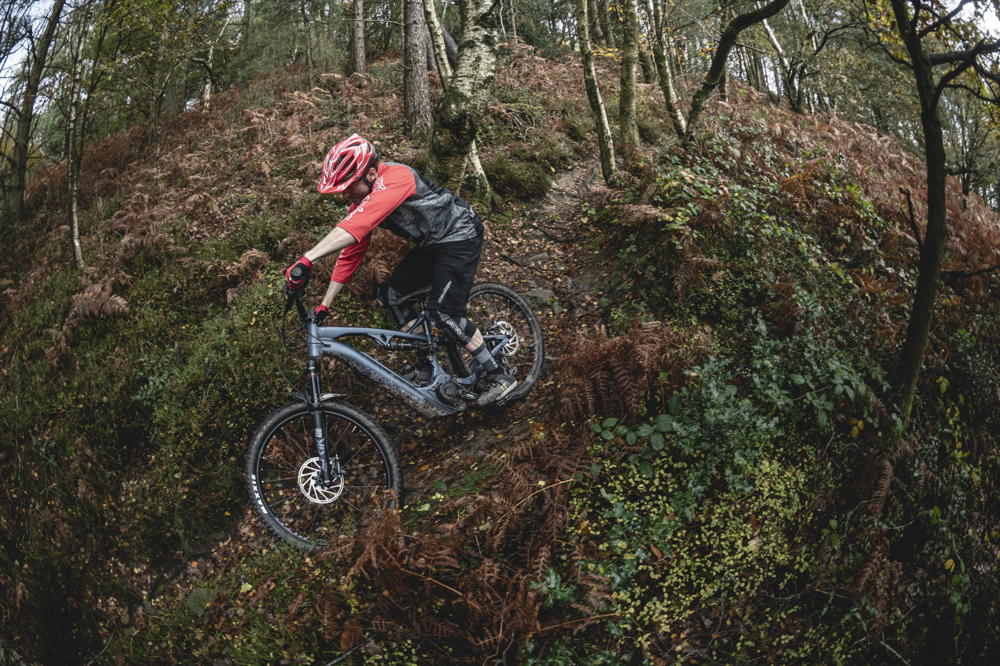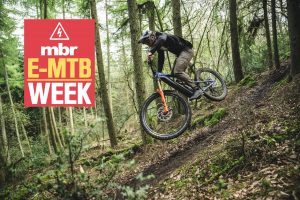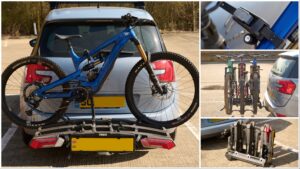Geometry and handling mirror a modern trail/enduro bike. The Bosch Gen 4 motor has power and control in equal measure. Durability is a key part of the design.
Whyte E-150 RS: first ride review
The big-hitting British marque takes its first pedal-assiste foray into the enduro e-bike arena. First ride review of the new Whyte E-150 RS e-MTB.
>>> Best electric mountain bikes for 2020
Whyte E-150 RS need to know
- The E-150 is Whyte’s first trail/enduro e-bike
- 6061 hydroformed alloy frame is designed around the new Gen 4 Bosch Performance Line CX motor
- The downtube houses as a 625Wh Bosch internal PowerTube with expandable capacity
- Travel is balanced at 150mm, and the bike rolls on 27.5in wheels shod with sturdy 2.5in tyres
- Entry-level E-150 S available for £4,740

Cloaked in secrecy and developed around the new Gen 4 Bosch motor, the E-150 RS combines everything Whyte has learnt about regular full-suspension bikes with the latest e-bike tech. With modern geometry, 150mm travel and 27.5in wheels, Whyte is billing the E-150 as trail/enduro e-bike designed to do it all.

Wide pivot stance improves frame stiffness
But how did Whyte even develop an e-bike when production versions of the new Bosch motor were in such short supply? In the prototyping stages Whyte rode a dummy motor and battery-housing full of chains to represent the true weight of the bike, just to get the geometry and suspension dialled in. Once the production motor and battery became available the pedal assist was layered on top of a sound design. It’s a somewhat unorthodox approach, but I’m convinced it’s why the Whyte E-150 is such an accomplished design.

Oversized down tube the only indication of electrical assistance
Why 27.5in wheels on a 150mm travel bike when the trend is for 29ers? In a nutshell, they are stronger. Current e-bike riders will already know that the wheels, especially the rear, take a pounding, so stronger is better. Also, because e-bikes are more stable than their non-motorised cousins, Whyte didn’t feel the need for the extra stability that 29in wheels offer, especially with the associated reduction in durability.

Bosch Gen 4 motor includes a set-and-forget E-MTB power mode option
There are additional benefits of the smaller wheels too. They offer the widest range of tyre choice, which lead Whyte to settle on 2.5in tyres, as that are available in the biggest choice of casings and compounds – Whyte opting for a reinforced Double Down casing Maxxis High Roller II on the rear for increased puncture protection.

150mm rear travel comes courtesy of RockShox Deluxe
The smaller wheels also make it easer for Whyte to offer a genuine XS frame size for the vertically challenged rider. In fact, there are five frame sizes to choose from and I had the opportunity to ride the size M and L back to back. At 5ft 11in I much preferred the fit and handling on the size L, probably because the 480mm reach is very similar to the non-pedal assist bikes that I currently ride.

Neatly nestled but easily accessible charging port
It’s the handling that really stood out though. Most of the e-bikes I’ve tested tend to have slightly over damped shocks, so the bike rides flat and doesn’t bob up and down when you’re sat down pedalling over rolling terrain. This also makes the bike feel more stable for a given frame size, but it’s a high price to pay if you’re a more dynamic rider looking to work the bike though turns, pop off drops or switch lines in the blink of an eye looking for the perfect setup. On the Whyte E-150 I instantly felt that I could do everything I wanted to.
And that’s because Whyte has bucked the trend for increased damping with a lighter shock tune. It makes perfect sense when you consider that the extra weight of the bike makes it inherently more stable, while the constant power from the motor smooths out even the most choppy pedal strokes. And it’s a move that really paid off.

The E-150 RS rides like a regular trail rig
Whyte E-150 RS: first ride review
The first thing you notice is how much more dynamic the E-150 is. At 24.77kg (54.6lb) it’s no lighter than any other e-bike I’ve ridden, but because you can load the shock and use the suspension to unweight the bike without getting bogged down in the damping, it’s super easy to manoeuvre.
And that’s why you need to get the correct frame size. On an over damped e-bike a smaller frame is actually easier to chuck around, but with the E-150 you want the correct size as it rides more like a regular bike. Which it great for anyone making the switch to a pedal assist e-bike.
In fact, my first experience on an e-bike was with the early Bosch motor and I’ll never forget the initial surge of power that made me feel super human and had me grinning from ear to ear. Yes, the compact driver cog clogged with mud and the motor lacked the light touch need for tackling slippery, technical climbs. With the new Gen 4 motor Bosch has addressed both of those issues. Thankfully, it has lost none of its grunt, so when you sprint hard the bike is instantly up to speed. With additional torque sensors in the motor is mediates that power much better on the climbs, the motor coming to life almost instantly, making it super easy to get moving again if you stall on a climb.
Apart from the oversized down tube that houses the 625Wh Bosch battery the silhouette of the E-150 looks remarkably similar to Whyte’s S-150 trail bike. Which is hardly surprising really, when Whyte played a large part in pioneering the 1x drivetrain and symmetrical rear ends, two feature that are common to most e-bikes.
To keep the weight of the battery centred on the frame and as low as possible, Whyte has clocked the motor and placed the batter in front and parallel to the motor, rather than on top of it. It’s why the frame protrudes more in front of the chainring that some other designs. It’s also why I had some concerns about grounding it out, especially with the low BB height. My initial concerns proved unfounded though, as I’ve yet to hit the frame. And if I ever do, there a protective cover in place to insure that nothing gets damaged.
The bike ships with an internal battery offering 625Wh of juice, and the frame had been design to accept bigger batteries as and when they become available. Best of all, if you want to remove the battery and charge it in doors you can in just a few simple steps.
One carry over from previous Bosch systems is the compact bar-mounted Purion display. It’s clear and easy to read, but when daylight is starting to fade I found the display to be too bright and distracting. Fortunately you can adjust the backlight and tone-down the stock settings.
Also the placement of the buttons for toggling between the power modes makes it tricky to use on rougher trails, so thankfully the E-MTB mode that automatically adjusts the level of assistance for you a genuine a set and forget feature. In fact, I only used the manual mode setting when the battery was running low and wanted to make sure that I had enough juice to make it back to the van.
So the E-150 RS feels a lot like a regular trail/enduro bike. Albeit, one that you can get twice as much riding done in the same amount of time. I loved the initial surge of power from the Bosch motor when you stand up to sprint or when smuggling in a quick crank to keep the tempo high. And don’t think for a second that it’s because I’m lazy. If anything, the Bosch motor actively encouraged me to pedal that much harder, because I know the payoff on the Whyte E-150 RS is so high. And not simply because it’s an e-bike. The Whyte E-150 RS is great bike period.
















